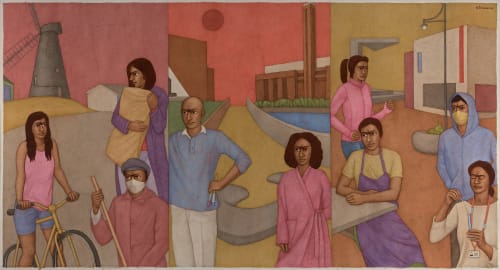Shanti Panchal’s (b.1951) exhibition Endurance opens at the gallery with a reception on Thursday 9 May from 6 - 8 pm. The exhibition runs from 10 May – 2 June 2024 and features works from 1989 – 2022. The exhibition is also a part of London Gallery Weekend from 31 May - 2 June 2024 for which the gallery will be open over the weekend. The Artist will be doing a tour of the show at the gallery on Saturday, 1 June at 4pm.
One of the highlights of the exhibition is a large-scale watercolour study done for the Brixton mural Endurance, which was part of a series commissioned by Art on the Underground for Brixton Underground station in London, which was on display from November 2022 – November 2023.
“It has been an exciting experience, painting for six months on the Brixton mural, exploring Brixton’s history, art and culture. I wanted to reflect and celebrate the vibrant cultural life in Brixton and London. We have suffered a great deal past few years but the resilience and healing powers of people have always found a way to overcome adversities throughout the history. People and places in the mural tell us a story of each community within Brixton and London. I feel that we have endured difficult and hard times in the past, facing challenges of the present and looking forward to a bright future. “
In this expansive work, Panchal captures a collective portrait reflecting our enduring resilience and interconnectedness. Depicting various Londoners engaged in different roles - an artist, an NHS worker, a waiter, among others - the painting also incorporates elements of the cityscape, including landmarks like the Black Cultural Archives, Brixton Windmill, and Tate Modern. Notably, it features memorials such as The African and Caribbean War Memorial and the Cherry Groce Memorial Pavilion in Windrush Square, symbolizing both cherished places and individuals, as well as the losses and struggles faced. These elements come together to celebrate, commemorate, and inspire as we navigate through shared experiences and strive to rebuild.
Panchal has also done two other public commissions in London - Across the Barrier, which was a part of the Anti-Racism Mural, GLC, Lowood Street, Shadwell, Tower Hamlets (1985) and the Roxborough Bridge Mural, Harrow (1994).
During his early years in London, as well as while traveling across Europe and America, Shanti noticed a historical neglect of watercolour's potential compared to oil and acrylic. Instead of exploring its depths, watercolour seemed confined to conventional subjects like flowers and landscapes, which proved frustrating for him. Unwilling to conform to these limitations, he embarked on an obsessive journey of artistic exploration.
His dedication led him to experiment with various sizes, from large canvases to small paper sheets. Seeking depth, he abandoned traditional colour mixing on palettes and opted to apply colours directly onto the paper, encouraging them to penetrate its fibres. Through relentless hammering and scraping, his process evolved, blending success and failure into each stroke. Layers upon layers of colour became a metaphor for life experiences, simultaneously ecstatic and despairing.
The earthy tones dominating his palette reflected his upbringing in a Gujarati village, inspiring a deeply personal visual language. His paintings depicted family life, where privacy was a foreign concept, yet each character carved out inner sanctuaries amidst their shared space, revealing poignant loneliness.
Despite the prevalent belief that "painting is dead", a notion persisting since the invention of photography in 1839, Shanti adamantly believed in its enduring relevance. For him, painting is not just alive but also uniquely meaningful, fuelling his dedication to push boundaries. He foresaw that the debate surrounding painting's relevance would persist into the 21st century and beyond, emphasizing its unparalleled ability to capture human nature and the cosmic forces shaping our existence.
While many contemporary artists pursued a detached, machine-like quality in their work, Shanti sought to infuse his creations with spiritual depth and passion. His influences range from the mystical visions of El Greco and William Blake to his own Hindu sensibility, grounding his vision in a rich tapestry of spirituality and tradition.
The exhibition is accompanied by a fully illustrated catalogue which includes a detail biography of the artist and an essay by writer, critic, and curator Andrew Lambirth.
